“The mandala symbolizes a safe refuge of inner peace.” – Judith Cornell, Ph.D., artist and mandala expert.
Mandalas, meaning “circle” in Sanskrit, are powerful symbols of cosmic order and unity. They connect our everyday world to higher consciousness, offering spiritual insights and hidden knowledge. Used in many cultures, mandalas help with relaxation, creativity, and expanding our consciousness.
They also help us access buried memories and unresolved conflicts from our unconscious. This aids in personal growth and healing.
Key Takeaways
- Mandalas are ancient symbols that tap into the collective unconscious, promoting spiritual transformation.
- Mandalas serve as gateways to accessing the unconscious mind, facilitating self-discovery and personal growth.
- Drawing or coloring mandalas can reduce stress, increase creativity, and foster emotional healing.
- Mandalas reflect universal harmony and order, connecting us to a deeper sense of purpose and meaning.
- Incorporating mandalas into daily spiritual practice can enhance well-being and foster spiritual growth.
Understanding the Sacred Origins of Mandalas
Mandalas are circular symbols with deep spiritual meaning in many ancient cultures. They are especially important in Hinduism and Buddhism. These patterns are rooted in the Sanskrit language and spiritual practices. They help people find inner change and higher awareness.
Sanskrit Roots and Cultural Significance
The word “mandala” comes from Sanskrit, meaning “circle” or “center.” In the Rig Veda, it refers to the text’s ten sections. This shows mandalas’ strong tie to Hindu traditions.
Historical Evolution Across Civilizations
Mandalas have appeared in many cultures. In Tibetan Buddhism, they are used for rituals and meditation. They also show up in Celtic and Native American traditions, and even in nature, like flower patterns and snowflakes. This highlights their universal message of harmony and order.
Religious and Spiritual Foundations
Mandalas have a deep spiritual purpose. In Hindu and Buddhist traditions, they help with meditation and represent the universe. The Vairochana mandala, for example, is used in Tibetan Buddhist funerals to remove negative energies.
“Mandalas are potent aids for meditation in Buddhist practices, aiding in focus, mental clarity, and achieving altered states of consciousness.”
The symbols in mandalas show the universe’s connection. They guide people to understand themselves and the divine. Mandalas have been key in Buddhist culture since the 4th century, used in rituals, meditation, and temple design.
Flower of Life Mandala
A geometrical pattern composed of multiple evenly-spaced, overlapping circles arranged in a flower-like pattern with six-fold symmetry.1 It’s considered a sacred geometric symbol representing the fundamental patterns and interconnectedness of all life in the universe.

Flower of Life Mandala
Seed of Life Mandala
Formed from seven overlapping circles, this mandala is considered the blueprint or starting point for the Flower of Life. It symbolizes creation, potential, and the seven days of creation in some traditions.

Seed of Life Mandala
Tree of Life Mandala
A mandala often depicted as a tree with roots, trunk, and branches, representing the interconnectedness of all things, growth, and the cycle of life, death, and rebirth. It can be found in various spiritual and mythological traditions.
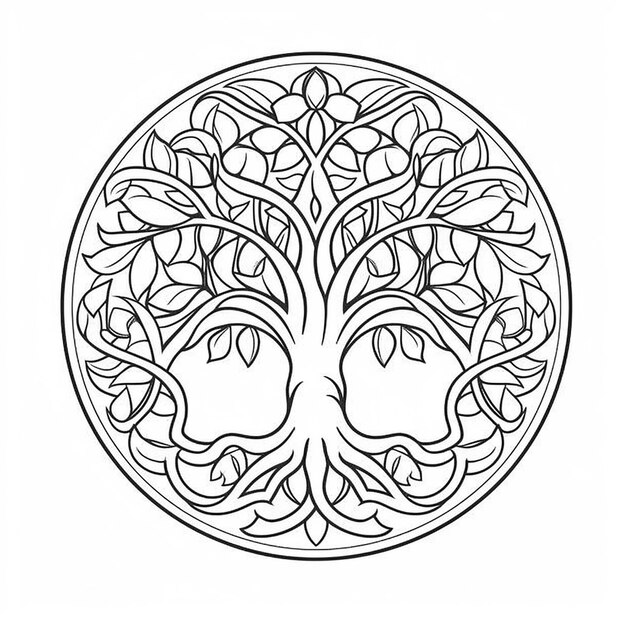
Tree of Life Mandala
Sri Yantra Mandala
A complex geometrical design composed of nine interlocking triangles that radiate outwards from a central point. It’s a sacred symbol in Hinduism, representing the union of the divine masculine and feminine, and the path to enlightenment.
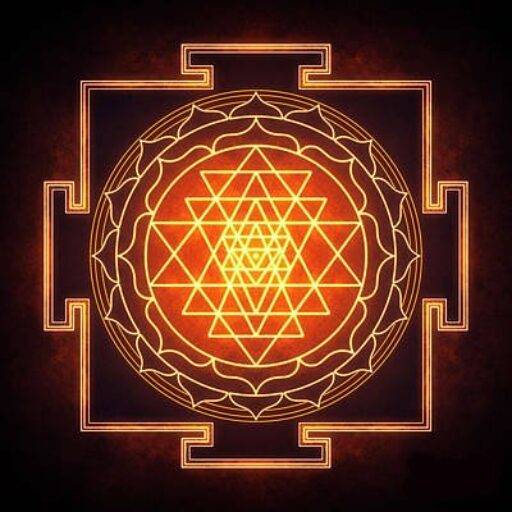
Sri Yantra Mandala
Kalachakra Mandala
A complex and symbolic mandala used in Tibetan Buddhism, representing the cosmos, the cycle of time, and the path to enlightenment. It’s often used in meditation practices and sand mandala rituals.

Kalachakra Mandala
Borobudur Mandala
The Borobudur temple in Indonesia is built as a massive mandala in three dimensions. It symbolizes the path to enlightenment through different levels of consciousness, represented by the temple’s terraces and structures.

Borobudur Mandala
Sand Mandala
Intricate and impermanent mandalas created using colored sand, often by Tibetan Buddhist monks. They represent the impermanence of life and the universe, and the process of creation and destruction.

Sand Mandala
Celtic Knot Mandala
Mandalas inspired by Celtic knotwork designs, featuring intricate interwoven patterns that symbolize eternity, interconnectedness, and the continuous flow of life.
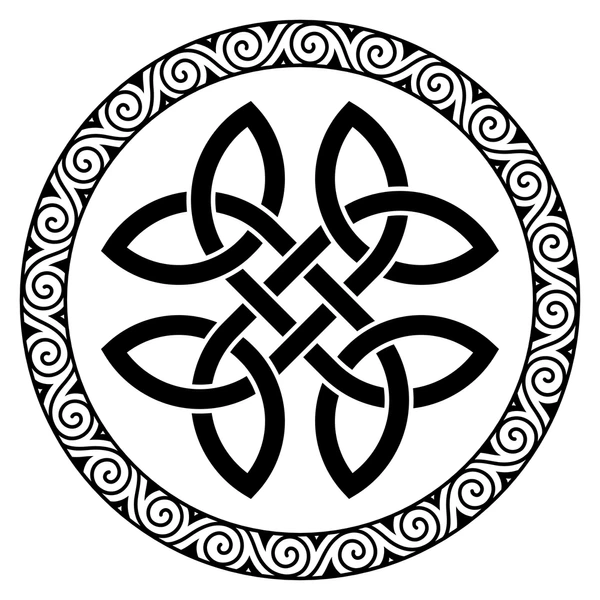
Celtic Knot Mandala
Modern Mandalas
Contemporary artists and individuals create mandalas in various styles and mediums, often incorporating personal symbolism and creative expression. These mandalas can be used for meditation, self-discovery, and artistic exploration.
Modern Mandala
Remember: Mandalas can be simple or complex, created with various materials and techniques. They hold diverse meanings and purposes across different cultures and spiritual traditions. Their intricate patterns and symbolism can be used for meditation, self-reflection, and artistic expression.
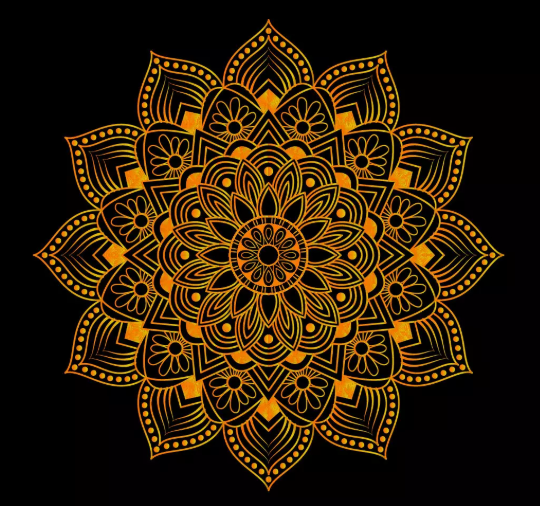
Using Ancient Mandalas for Inner Transformation
Mandalas are seen as powerful tools for Spiritual Growth Practices and inner change. These sacred designs help calm the mind and reach deeper consciousness. They are used in Meditation and Mandalas.
By drawing, coloring, or just thinking about mandalas, you start a journey of self-discovery. Mandalas show balance and harmony, leading to personal growth and enlightenment.
“Mandalas have been used for centuries to help seekers find harmony and balance, create order and balance out of chaos, and connect with the sacred, and higher purpose of life.”
Creating a natural mandala is a unique way to meditate and be creative. You use elements from nature like leaves and stones to make a circle. This connects you with the natural world.
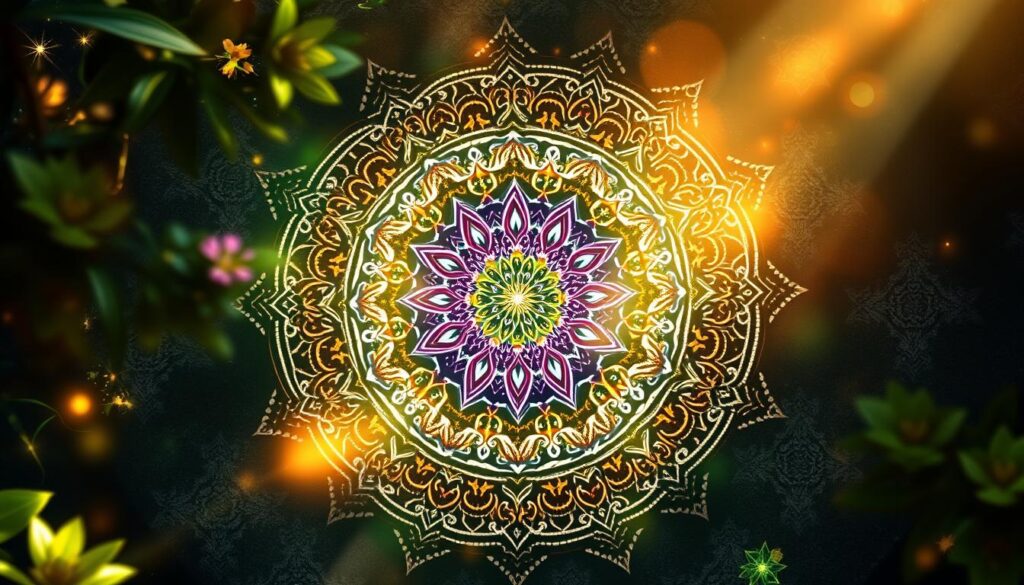
As you add more to your mandala, you might feel a sense of flow and peace. Knowing these mandalas are temporary reminds us of life’s fleeting nature and constant change.
Working with mandalas, whether traditional or natural, can deeply transform you. It helps find harmony, balance, and a closer bond with the sacred within and around us.
The Psychology Behind Mandala Healing
Carl Jung, a famous psychologist, studied mandalas deeply. He saw mandalas as symbols of the self and complete personality. Jung drew mandalas every day to show his inner state, finding their deep power for growth and integration.
Accessing the Unconscious Mind
Mandala therapy lets people reach hidden emotions and unite different parts of themselves. It helps on the path to becoming a complete person. By working with mandalas’ symbols, you can uncover parts of your mind, leading to personal and spiritual growth.
Integration of the Self Through Mandala Work
Mandalas’ circular shape shows the unity of the self. Creating your mandala is a journey of self-discovery. It lets you express your deepest thoughts and feelings through shapes and colors. This helps you understand and accept yourself fully.
“The mandala is the psychological expression of the totality of the self.” – Carl Jung
Using Jungian Psychology and mandalas’ sacred geometry can unlock your unconscious. This opens the door to deep healing and change. Start this journey of self-discovery and let mandalas lead you to a more complete life.
Sacred Geometry and Spiritual Symbolism in Mandalas
Mandalas are more than just beautiful designs. They are tools for personal growth and spiritual development. These circular patterns use sacred geometry and carry deep spiritual symbolism. They connect us to the universe.
The designs in mandalas are not just for looks. They hold deep meanings tied to the universe’s structure. Circles stand for perfection and eternal cycles, showing unity and wholeness. Spirals, meanwhile, symbolize growth and the endless nature of life.
Mandalas reflect the universe’s interconnectedness. The Shri Yantra is a prime example, showing the cosmic essence. Gothic cathedrals’ rose windows are also mandalas, filled with divine geometry.
Diving into mandalas’ sacred geometry and spiritual symbolism reveals a world of deep insights. These archetypal symbols encourage self-discovery and personal growth.
| Geometric Shape | Spiritual Significance |
|---|---|
| Circle | Perfection, Eternal Cycles, Wholeness, Unity |
| Spiral | Growth, Transformation, Renewal, Infinity, Eternity |
| Labyrinth | Introspection, Reflection, Stress Relief, Clarity |
| Mandala | Balance, Harmony, Healing, Connection to the Divine |
Exploring mandalas’ sacred geometry and spiritual symbolism can lead to deep personal and spiritual changes. As you engage with these symbols, you’ll uncover the universe’s mysteries and your own inner world.
Mandala Meditation Techniques for Spiritual Growth
Mandalas are powerful tools for meditation and spiritual growth. They help you enter a deep state of consciousness. This can lead to relaxation and a deeper understanding of yourself.
To get the most out of mandala meditation, set up a special space. Use specific visualization methods that match your spiritual path.
Preparation and Setting Sacred Space
Start by making a peaceful space for meditation. Pick a quiet, comfy spot where you won’t be disturbed. Add things like candles, incense, or crystals to make it feel sacred.
Take a few deep breaths to calm down. This helps your mind focus and relax.
Visualization Methods
- Look at a physical mandala, like a printed image or sand mandala. Let the patterns and symbols calm your mind.
- Imagine a mandala in your mind. See the circles and shapes clearly. Picture it growing and shrinking.
- Try a guided mandala meditation. A teacher or audio will walk you through it. It’s great for beginners.
Integration Practices
After meditation, think about what you learned. Think about how to use these insights in your daily life. Write in a journal, move mindfully, or try other practices to deepen your connection to mandalas.
“The mandala is an archetypal image whose structure is rooted in the basic patterns of human consciousness.” – Carl Jung
Using Meditation and Mandalas and Spiritual Growth Practices can open new doors. You’ll gain self-awareness, peace, and a stronger connection to the divine.
Color Symbolism and Energy in Mandala Practice
Mandalas are more than just pretty designs. They carry deep symbolism and energy. The colors in mandalas can change how we feel, balance our chakras, and improve our well-being. Learning about these colors can make your Chakra Balancing with Mandalas and Healing Mandala Rituals even more powerful.
Each color in mandalas has its own special meaning. Yellow stands for joy, clarity, and thinking. Blue brings healing, peace, and helps us communicate. Purple connects us to mystery, spirituality, and higher thoughts. Choosing colors that match your goals can help you grow and change.
When you meditate or make mandalas, notice the colors that catch your eye. These colors can tell you a lot about your feelings and spirit. Using colors that attract you can help balance your energy and bring harmony.
Color is key in mandala practice. It helps us connect with different parts of ourselves. Whether you’re balancing chakras or healing, color can deepen your spiritual journey and help you discover more about yourself.
“Mandalas are a window into the soul, allowing us to see the intricate patterns and rhythms that govern our inner and outer worlds.” – Dr. Judith Cornell, author of “Mandala: Journey to the Center”
Creating Your Own Healing Mandalas
Making your own healing mandalas is a powerful journey. Mandalas are known for their deep meanings and designs. They help with meditation, self-discovery, and spiritual growth. By making your own mandala, you can use their healing power and add your own energy and wishes.
Essential Materials and Setup
To start making mandalas, you need simple art supplies like paper, pencils, and markers or colored pencils. Choose a quiet place to work where you can focus. Set your goal to make a mandala that helps with Mandala Art Therapy and Healing Mandala Rituals.
Step-by-Step Creation Process
- Begin by drawing a circle in the middle of your paper. This is the base of your mandala.
- Add patterns and shapes around the circle that mean something to you. Let your intuition guide you.
- Think about the colors and textures you use. They can carry deep meanings.
- After you’re happy with your mandala, you can color it or add more details. This makes it even more personal.
Infusing Personal Meaning
The real strength of a healing mandala is its connection to your inner self. Think about symbols or images that are important to you. This could be from nature, your faith, or abstract shapes. Adding personal touches makes your mandala more powerful and meaningful.
Making mandalas can calm your mind and lower stress. It’s a way to find peace, understand yourself better, and grow spiritually.
“Mandalas are not just beautiful patterns; they are powerful tools for self-discovery, healing, and transformation. Each one is a reflection of the artist’s inner world.”
Incorporating Mandalas into Daily Spiritual Practice
Adding Spiritual Growth Practices and Meditation and Mandalas to your daily life can greatly help your self-discovery journey. Mandalas, with their special geometry and meaning, are great tools for deepening your spiritual practice. They help you connect more deeply with the divine.
Start your day by making a simple mandala drawing. This act can help you focus, set your day’s goals, and connect with mandalas’ wisdom and balance. As you work on the design, let your intuition guide you, making it personal.
Throughout the day, include mandala meditation in your routine. Look at a mandala image and let its beauty calm you. It can lead you to a peaceful state and higher awareness.
Also, use mandalas for intention setting and making your dreams come true. Imagine your goals, then draw a mandala that shows what you want. Doing this often makes your dreams feel real and achievable.
Let mandalas be a big part of your daily Spiritual Growth Practices. They can help you find inner peace, emotional balance, and a stronger connection to the universe.
| Benefits of Incorporating Mandalas into Daily Spiritual Practice |
|---|
| Enhances focus and concentration |
| Promotes relaxation and stress relief |
| Supports emotional healing and self-discovery |
| Fosters a deeper connection to the divine |
| Encourages a sense of balance and wholeness |
“The mandala is an archetypal image whose basic motif is the circle, representing the wholeness of the psychic and spiritual aspects of the human being.” – Carl Jung
Conclusion
Mandalas have been a key part of spiritual growth for ages. They have crossed cultural lines and kept their power alive. These sacred shapes help us find ourselves, heal, and become more aware.
Exploring mandalas’ history and meaning has shown their deep impact on us. They help us grow personally and spiritually. Through meditation, art, or therapy, mandalas guide us through tough times. They bring us peace and balance.
Keep exploring mandalas for your inner journey. May they bring you comfort, spark your creativity, and guide you to self-discovery. The wisdom of mandalas is yours to use. Your path to growth and enlightenment is wide open.
FAQ
What are mandalas, and how do they connect to spiritual growth?
Mandalas are circles with deep meaning. They connect our everyday world to higher states of consciousness. Drawing or coloring mandalas can lead to deep insights and personal growth.
What are the historical and cultural roots of mandalas?
Mandalas come from ancient cultures, especially Hinduism and Buddhism. They appear in many cultures, like Tibetan Buddhism and Native American traditions. Mandalas also show up in nature, like flowers and snowflakes, symbolizing harmony.
How do mandalas facilitate inner transformation and spiritual growth?
Mandalas are powerful tools for growth. They help calm the mind and reach deeper consciousness. Their designs reflect nature and the universe, connecting us to the cosmic.
What is the psychological significance of mandalas, and how did Carl Jung utilize them?
Carl Jung saw mandalas as symbols of the self. He drew them daily to explore his mind. Mandala therapy helps us face our emotions and become whole.
What is the significance of sacred geometry and spiritual symbolism in mandalas?
Mandalas use sacred geometry and symbols. They show the universe’s patterns, linking us to the cosmic. Different shapes and patterns in mandalas represent various aspects of existence.
How can mandala meditation techniques support spiritual growth?
Mandala meditation involves focusing on mandala designs. It can lead to deep relaxation and awareness. Creating a sacred space and using specific methods can enhance the experience. Integrating insights from meditation into daily life supports spiritual growth.
What is the significance of color symbolism in mandalas?
Colors in mandalas have meanings. Yellow is joy, blue is healing, and purple is spiritual. Choosing colors can affect our emotions and energy. Understanding color symbolism can make mandala practices more effective.
How can you create your own healing mandalas?
Making mandalas is a calming process. You’ll need paper, pencils, and coloring tools. Set an intention, draw symmetrical designs, and color. Adding personal meaning makes the mandala more powerful. Creating mandalas can reduce stress and promote relaxation.
How can you incorporate mandalas into your daily spiritual practice?
You can use mandalas in many ways. Try morning drawing, meditation, or setting intentions with them. Regular use supports spiritual growth, emotional balance, and self-discovery. Mandalas can help with stress and well-being.




























































